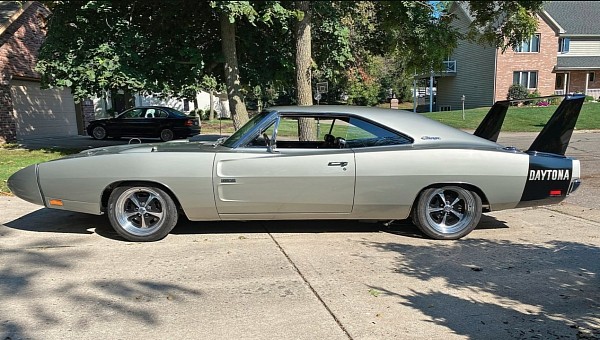The 1969 Dodge Charger Daytona is one of the most beloved muscle cars from that golden era. There used to be five, but now there are only three remaining in the correct A4 Silver Metallic with a Black tail stripe paint job. When you pair its looks with what lies underneath the hood, there's no denying that this could fly off the auction block faster than you can say 631 horsepower (640 ps).
The Charger Daytona was brought to life from Dodge's desire to steal the thunder from Ford's accomplishments in the NASCAR championships. So after enough blood, sweat, and tears, the engineers at Dodge came up with this amazing specimen you see before your eyes.
They took the Charger R/T, slapped a rear wing on its trunk and a front steel cone to improve aerodynamics, together with a lot more tweaking here and there, and bada bing, bada boom, it started wreaking havoc in races. It was also the first official NASCAR vehicle to break the 200 mph (322 kph) limit. This was happening on March 24, 1970, at the Talladega Super Speedway, with legend Buddy Baker behind the wheel.
The street-legal variants came with lesser specifications for obvious legal reasons. This Charger Daytona originally came with a 440-cubic-inch (7.2-liter) V8 engine. In its fresh-out-of-the-factory trim, it could output 375 horsepower (380 ps), which is more than respectable.
However, this multi-year rotisserie restored beauty now has a titanic 542-cubic-inch (8.8-liter) Hemi V8 that can deliver up to a whopping 631 horsepower (640 ps). According to the auction's website, these figures have been tested on the dyno at 5,800 rpm.
The entire project was handled mainly by three business entities. The new engine was fitted by Best Machine Racing Engines of Farmington Hills, Michigan. The restoration was done by Troy Angelly & T/A Restorations of Eldorado from Florida.
The final assembly was completed in 2019 by US 12 Speed & Custom based in New Buffalo, Michigan. Important to note is that the rotating components and block were treated with nitride and balanced in accordance with racing specifications.
These specs also mean that the car was converted to a manual transmission using a rebuilt low-mileage 1968 Chrysler Hemi 4-speed. It also has a Hotchkis suspension lowering front by 2 inches and rear by 1 inch, with other suspension updates including UMI A-arms, custom Bilstein gas shocks, and Cal-Trac traction bars.
It comes with a huge list of the entire work that went into this car, but far be it from me to bore you with further details. However, you can rest assured knowing that a new anti-theft system was added, and it still has both of its original jacks. I'm sure the latter is enough on its own to convince anyone attending the Mecum Auctions event to pull the trigger on this gem.
They took the Charger R/T, slapped a rear wing on its trunk and a front steel cone to improve aerodynamics, together with a lot more tweaking here and there, and bada bing, bada boom, it started wreaking havoc in races. It was also the first official NASCAR vehicle to break the 200 mph (322 kph) limit. This was happening on March 24, 1970, at the Talladega Super Speedway, with legend Buddy Baker behind the wheel.
The street-legal variants came with lesser specifications for obvious legal reasons. This Charger Daytona originally came with a 440-cubic-inch (7.2-liter) V8 engine. In its fresh-out-of-the-factory trim, it could output 375 horsepower (380 ps), which is more than respectable.
However, this multi-year rotisserie restored beauty now has a titanic 542-cubic-inch (8.8-liter) Hemi V8 that can deliver up to a whopping 631 horsepower (640 ps). According to the auction's website, these figures have been tested on the dyno at 5,800 rpm.
The entire project was handled mainly by three business entities. The new engine was fitted by Best Machine Racing Engines of Farmington Hills, Michigan. The restoration was done by Troy Angelly & T/A Restorations of Eldorado from Florida.
The final assembly was completed in 2019 by US 12 Speed & Custom based in New Buffalo, Michigan. Important to note is that the rotating components and block were treated with nitride and balanced in accordance with racing specifications.
These specs also mean that the car was converted to a manual transmission using a rebuilt low-mileage 1968 Chrysler Hemi 4-speed. It also has a Hotchkis suspension lowering front by 2 inches and rear by 1 inch, with other suspension updates including UMI A-arms, custom Bilstein gas shocks, and Cal-Trac traction bars.
It comes with a huge list of the entire work that went into this car, but far be it from me to bore you with further details. However, you can rest assured knowing that a new anti-theft system was added, and it still has both of its original jacks. I'm sure the latter is enough on its own to convince anyone attending the Mecum Auctions event to pull the trigger on this gem.










